Defining Techniques: The Use of Chiaroscuro in Art
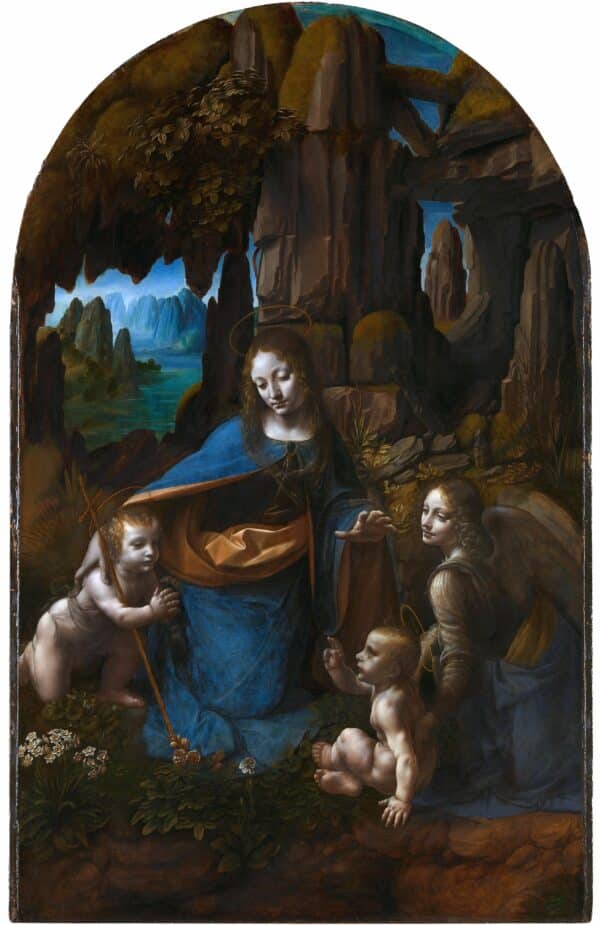
Leonardo da Vinci, Madonna of the Rocks, c. 1491/2-9 and 1506-8
The word ‘chiaroscuro’ is an Italian term that directly translates into “light” (chiaro) and “dark” (scuro). It is a technique that has been used by artists dating back to early Greek and Roman art. However, Leornardo da Vinci is frequently credited with ‘bringing Chiaroscuro back’ to the forefront of painting techniques during the Italian Renaissance.
What Defines Chiaroscuro?
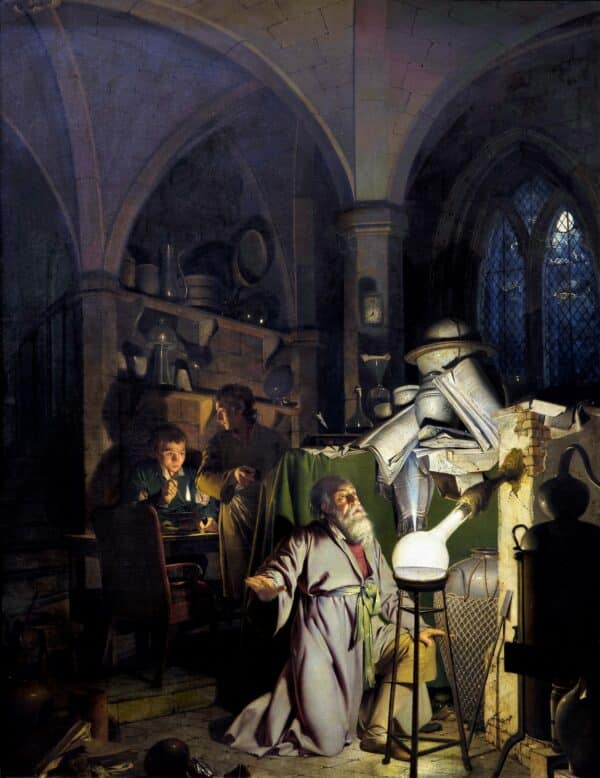
Joseph Wright of Derby, The Alchymist in Search of the Philosopher’s Stone, 1771
Artists’ employ chiaroscuro to create drama, depth, perspective and focus in their paintings. Shadowed areas of the composition are intentionally darkened whereas areas on which light falls are brightened and emphasised.
This heightened contrast of tones is used by different artists with different intentions, depending on the movement and subject matter. For example, the use of chiaroscuro in Madonna of the Rocks (first image above) allows da Vinci’s figures to appear more three-dimensional. It also elevates the status of the divine and highlights the depth of the composition.
On the other hand, a few centuries later, we see chiaroscuro being used to create tension and emotion in Joseph Wright of Derby’s The Alchymist in Search of the Philosopher’s Stone (above). Here, a jet of bright blue light shoots out of the glowing flask and illuminates the face of the Alchemist. His companions are lit by the light of a candle and the full moon in the window. The rest of the room is cast in shadow and the viewer’s focus is on the fixated expressions of anticipation as the party hopes for a successful scientific discovery.
The Difference between Chiaroscuro and Tenebrism
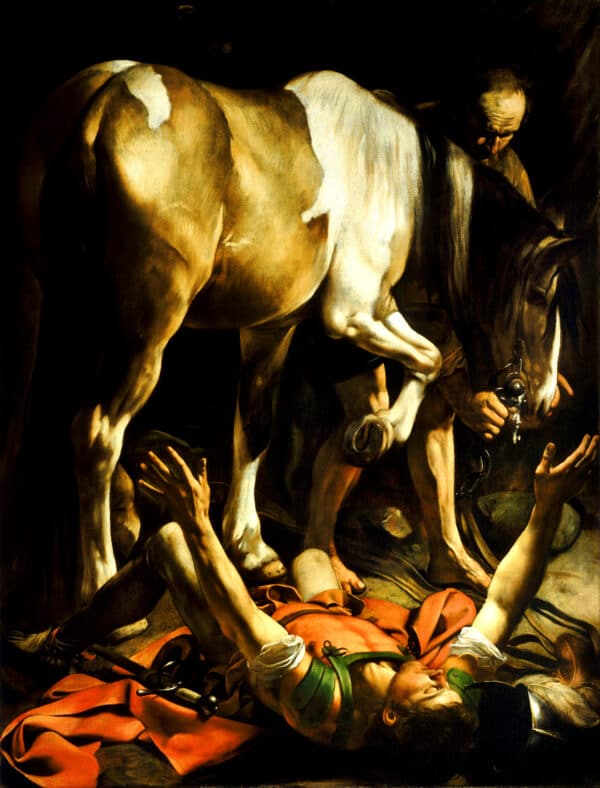
Caravaggio, Conversion on the Road to Damascus, 1600
In order to understand chiaroscuro, it is helpful to know the difference between it and its close companion tenebrism.
Chiaroscuro and tenebrism are terms that are frequently used interchangeably when analysing artwork. However, when getting down to the nitty gritty in painting technique terminology, there is a distinction between the two.
Like chiaroscuro, tenebrism comes from the Italian language. Derived from the word ‘tenebroso’, the technique specifically relates to the “scuro” part of chiaroscuro. Directly translated, tenebroso means dark or obscuring, essentially making tenebrism a more intensified form of chiaroscuro.
Its original use and rise in popularity is generally attributed to the Italian Baroque master Caravaggio, who took chiaroscuro and ran with it. In his paintings, especially those completed later in his career, Caravaggio elevated the contrast between light and dark to the extreme. Backgrounds would often become almost entirely black while the highlighted subject matter is emphasised greatly by dazzlingly bright light.
Returning to Chiaroscuro
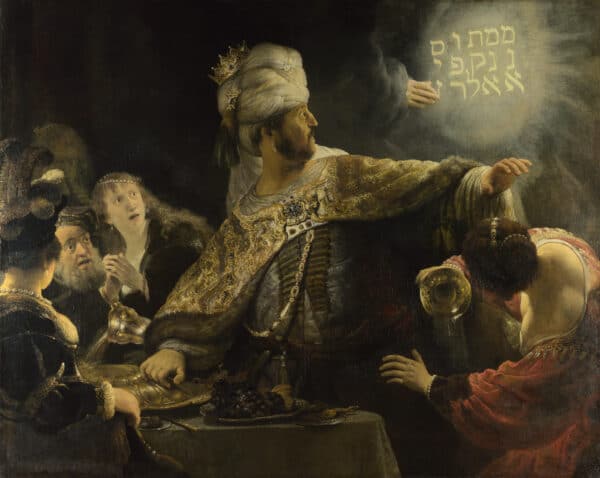
Rembrandt, Belshazzar’s Feast, 1636-38
Caravaggio’s work (and personal antics) shook the artworld in more ways than one and his use of chiaroscuro and tenebrism inspired artists across Europe. Many of whom travelled to Italy from the Netherlands and returned with chiaroscuro on their minds.
Amongst them was Utrecht artist Gerard van Honthorst, whose admiration for Caravaggio’s work led him to become known for the use of light and shadow in his own paintings. After studying in Rome from 1610 to 1612, van Honthorst left with the nickname “Gherardo della Notte” which fondly refers to his excellent nighttime scenes that are often lit by candle light.
Chiaroscuro in The Matchmaker by Gerard van Honthorst
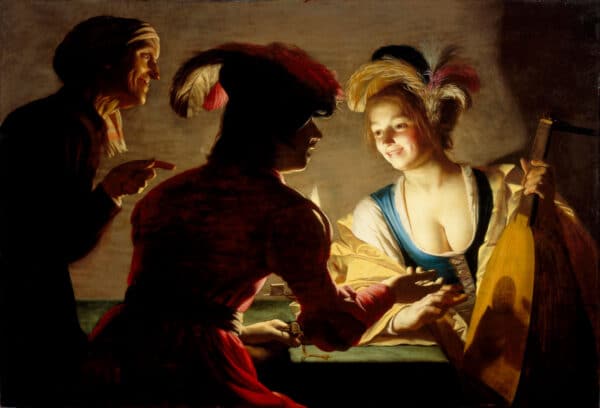
Gerard Van Honthorst, The Matchmaker, 1625
A prime example of chiaroscuro in van Honthorst’s candle-lit compositions is his painting known as The Matchmaker, painted in 1625. Within this work we witness a deal being settled between a lady of the night, her client and the arranger of such encounters. Whilst many of Caravaggio’s religious scenes are lit by an unseen lightsource (an allusion to divine light) a single flame is used by van Honthorst to light the shadowy room – evocative of the frivolous nature of the painting.
In the centre of the composition the candle flickers atop a table cloth. It only just appears behind the middle figure’s shoulder, rendering him unidentifiable. Whilst both men are dimly lit, the young woman is illuminated in a classic demonstration of the chiaroscuro technique. The shadow cast on the men consequently emphasises the yellow glow radiating on to the girl’s chest, her rich blue bodice, her rosy cheeks and her gleaming smile.
Here van Honthorst has perfectly captured the tone of this meeting through his use of chiaroscuro. An element of mystery is retained through the depiction of shadowy male figures while the candle brings us clarity regarding the lady’s profession. Intriguing, enigmatic and a little bit dramatic The Matchmaker is a brilliant example of Dutch Golden Age Baroque.
Chiaroscuro in Real Life
Whether it be in paintings or in real life, here at Blue & White Company we love using candles to help create an atmosphere in our homes. Perfect for bringing a touch of elegance to a dinner party or simple meal, or to enhance a moment of calm in your own private space, our candle selection is ready to be explored. As well as candles, we also have a wonderful variety of tablecloths and napkins available to help set the tone as you dine – however, perhaps not the same tone as we’ve just seen in The Matchmaker!
“Remember, light and shadow never stand still.”
Benjamin West, 1738-1820